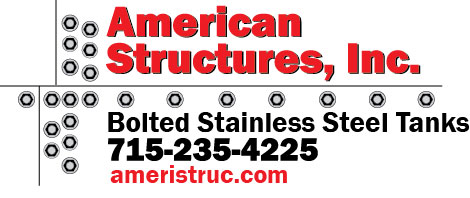Non-Potable Water Storage Tanks include clarifiers, equalization tanks, SBR tanks, weirs, filter tanks, and secondary containment tanks, which provide storage options for the containment, storage, and processing of waste water, re-use water, run-off water, and fire protection water.
Sludge Tanks
Sludge tanks are used in the storage and processing of food, animal waste, human waste, and landfill waste. During a water treatment process, solids are allowed to settle out of wastewater. These solids are clumps of bacteria and organic materials (activated sludge).
Anaerobic Digesters
Anaerobic Digesters carry out the breakdown process of waste water without the presence of oxygen. Such processes include: extended aeration, trickling filtration, and rotating biological contactors.
Aerobic Digesters
Aerobic Digesters are utilized in the aerobic treatment of waste water, a process by which microbes decompose complex organic compounds in the presence of oxygen.
Aeration Tanks
Aeration Tanks are chambers used to inject air into water for processing the water in some manner.
Leachate Tanks
Leachate Tanks provide containment for leachate. Leachate is defined as water that collects contaminants as it trickles through wastes, pesticides or fertilizers. Leaching may occur in farming areas, feedlots, and landfills, and may result in hazardous substances entering surface water, ground water or Bio Tower/Filter tanks. Bio towers and tanks are storage containers that hold media or filtering products to filter water during a purification or treatment process. Filter tanks harbor filter machinery, which are used to restore water quality by trickling water down through several layers of filter media. Filtration is a treatment process, under the control of qualified operators, for removing solid (particulate) matter from water by means of porous media such as sand or a man-made filter; often used to remove particles that contain pathogens.
Methane Generators
Methane Generators are tanks that are utilized to produce methane gas, also known as swamp gas, which is a colorless, nonpoisonous, flammable gas created by anaerobic decomposition of organic compounds. Methane is a useful alternative fuel and can be produced from bio-waste such as vegetation and manure.
Clarifier Tanks
Clarifier Tanks allow solids to settle to the bottom of the tank and are subsequently removed as sludge. During a water treatment process, solids are allowed to settle out of the wastewater in the clarifiers. These solids are clumps of bacteria and organic materials (activated sludge). Activated sludge is removed from the bottom of the clarifiers and either returned to oxidation ditches or sent to the digesters for further processing.
Equalization Tanks
Equalization Tanks hold wastewater in order to allow solids to begin settling. Activated sludge from leveling ponds is mixed with the wastewater in equalization tanks to begin biological digestion of organic contaminants.
Frac Water Tanks
Frac Water Tanks are generally steel storage tanks used to hold liquids, typically used for fracing wells in the oil and gas industry. A frac tank may also be used to store any liquids like run-off water, diesel fuel, glycol, oils, waste products, etc.

